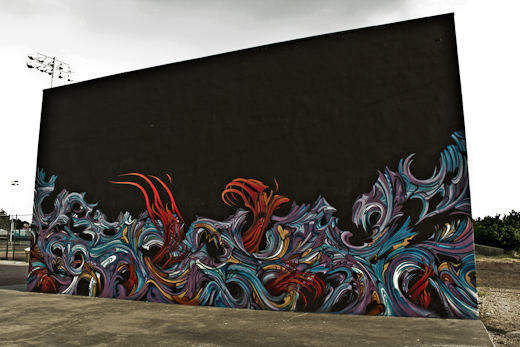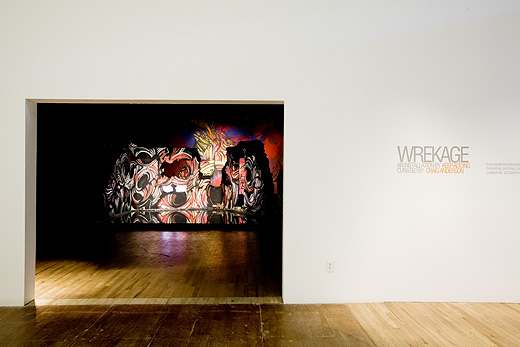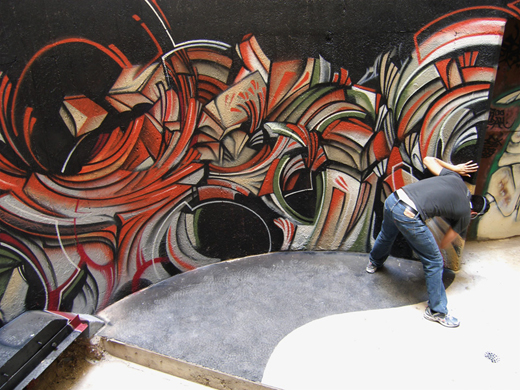
Interview: Keep Adding’s Mural Project in Las Cruces
Keep Adding is a multimedia art collective of artists Brian Bixby and Noah McDonald that emerged in Las Cruces, New Mexico in 2000. Although Keep Adding has executed projects throughout the country and Europe, the group returned to Las Cruces in September this year to paint “Wave Nest”””a 24-foot by 48-foot mural.
I interviewed Noah MacDonald, about graffiti art, the work of Keep Adding, and their latest mural project, “Wave Nest.”
Katy Crocker: What is Keep Addings identity?
Noah McDonald: Very large, abstract, digital-based, graffiti-based, technology-based art. We do site-specific installations, post street murals, large-scale designs, light boxes. Most of the art we do is technology-based. The idea of Keep Adding is loud and aggressive; its sharp, and angular.
KC: Why are you inspired to paint murals?
NM: I didnt grow up in New York, where every other corner was some big pink and green and blue graffiti piece. I never saw that kind of stuff (in New Mexico). I do this work because I want to see it. I want to make something that is louder than the other murals in town. Maybe thats why I paint the way that I do.
KC: Where you born in Las Cruces?
NM: I wasnt born there, but basically grew up in Las Cruces. I was born in Oklahoma City. My mom grew up in Taos. So, I spent a lot of time in northern New Mexico, too. I consider myself New Mexican.
KC: What brought your family to New Mexico?
NM: My dad is a paleontologist, so thats what brought us to Las Cruces. His paleontological discovery in southern New Mexico was just turned into a national monument.
KC: How did you meet Brian, the other half of Keep Adding?
NM: We met in New Mexico when we were younger. Weve been friends since middle school, and weve been doing art since then””comic book drawings, which later escalated into bigger drawings.
KC: Were you formally trained as an artist?
NM: I dont have any formal training.
KC: When did Keep Adding take shape?
NM: In 2000 Brian and I decided to give a name to the collaboration that we had been working on. We called it Keep Adding. We took a lot time considering how we were perceived as artists.
KC: Do you both work on every project?
NM: In most cases, its both of us working on a project. Occasionally it will be just him, or me, working independently under the Keep Adding identity. Depending on the project, we will collaborate with other painters, sound artists, or video artists, too.

Keep Adding, installation of "Wrekage", 2006. Installation view, Center for Contemporary Art, Santa Fe, NM
KC: Sometimes you take the street art indoors, like in “Wreckage, Santa Fe,” Keep Addings exhibition at the Center for Contemporary Art in Santa Fe (2006-7). How does the division of labor work? Do you, or Brian, have specific specialties, or do you both work on everything?
NM: In most cases we both work on everything, but Brian is not a muralist. And, Brian tends to do more of the video art. “Wreckage” had a multi-media component. We basically built a fake house, and in the framing of the house we built in screens into the walls. That piece ran for three months at the center. And, then, when it was done, it was literally torn down.
KC: How does an exhibition like “Wreckage, Santa Fe” differ from outdoor murals? Do your outdoor murals have a multi-media component, too?
NM: Outdoor pieces dont have any multi-media component physically to them. But, the actual making of these pieces has a multi-media element. For example, with the “Wave Nest” mural, there is a multi-media component to that piece that most people might not see when they walk up to the wall. To make that painting, in this particular case, I photographed the wall. Then, I created a digital mock-up of what the wall would look like after it was painted. And, I used that digital mock-up as a loose guide to paint. And this process continued: I would take photos of the wall while it was in process, and take those photos home, rework it on the computer, and get new ideas. But, all the detail is freestyle.
KC: Did the City of Las Cruces commission you to paint “Wave Nest?”
NM: The City of Las Cruces did commission, “Wave Nest,” specifically, Craig Fenske from Keep Las Cruces Beautiful. It is considered a permanent mural for the City of Las Cruces.
KC: What was your favorite moment working on the “Wave Nest” mural?
NM: At one point when I was painting, there was this old guy standing behind me, who only spoke Spanish. And, I asked him what he thought. He said some things in Spanish that I didnt get. All I could get that he was saying was “muy bonito.” And, he had a big smile on his face, and he was giving me the thumbs up! That made my day. It doesnt matter what the intelligent, upper-echelon of people thinks, all that matters is that this guy, this guy, appreciated it.

Keep Adding, "Silo", photo of work in-progress, 2006 El Paso, Texas Spray paint on concrete (silo)
KC: How did you begin spray painting?
NM: I started doing graffiti when I was about 15, and Im 34 now. Ive done my fair share of tagging. Because of where I lived, close to the Mexico border, there were a lot of gangs; I was a good artist and I could draw. So, I started spray painting. I got into a crew of graffiti artists in my early twenties. We would go street bombing, and painting in alleys. But, then, I started realizing that I looked at spray paint in a much more complex way. I didnt want to spend one hour painting a wall, sneaking out at 3 in the morning, looking over my shoulder. I wanted to spend 5 to 10 days coming back to the same place. I started doing this work more reclusively, inside of buildings.
KC: When you started painting on the inside of buildings, what was the response of your peers?
NM: I was outed by my own people; (they said) “Youre not even a graffiti artist anymore, youre like an artist.” So, its funny: in the graffiti artists world Im an artist, but in the artists world Im a graffiti artist. The term artist doesnt even mean anything anymore. As far as Im concerned someone who crochets is an artist. Someone who designs plastic trashcans is an artist; everybody is an artist.
KC: How do you feel about the term “˜graffiti art in relation to your work?
NM: I do not use the word graffiti lightly around my work, because of the negative connotations that it has. Its a tricky term. I dont even look at what Im doing as graffiti art anymore. I understand the difference between painting your name on someones house and someone taking their time to paint something more interesting and beautiful.
I like graffiti. I think its important socially. Public officials absolutely hate (graffiti art); its illegal. But, for someone to say that we cant paint on walls, which is something weve been doing since mankind began, is like knocking away at our human existence.
KC: So, whats next for Keep Adding?
NM: Brian and I are working on some projects that need another year, or year and half to finalize. We are excited about these new projects! Keep Adding is talking to new galleries in the US and in Germany. Thats why Brian is travelling to Germany for three months, and Ill join him over there.
Keep Adding might be overseas for a while, but you can see their work throughout the US. If you live near Las Cruces, go check out “Wave Nest.” Visit their website for news and projects (KeepAdding.com). Also, Apple Pro recently conducted an interview with Keep Adding.

I had talked to Noah almost every single day while he was doing this installation because it was across the street from my house. I love seeing this kind of work in my community because it inspires people like me to strive to become a better artist. I am an aerosol/street artist myself and Noah’s installation has inspired me to do more murals within the city where I live, and to keep pushing myself to create better works of art as often as possible. I hope to one day be a respected street artist within my community.